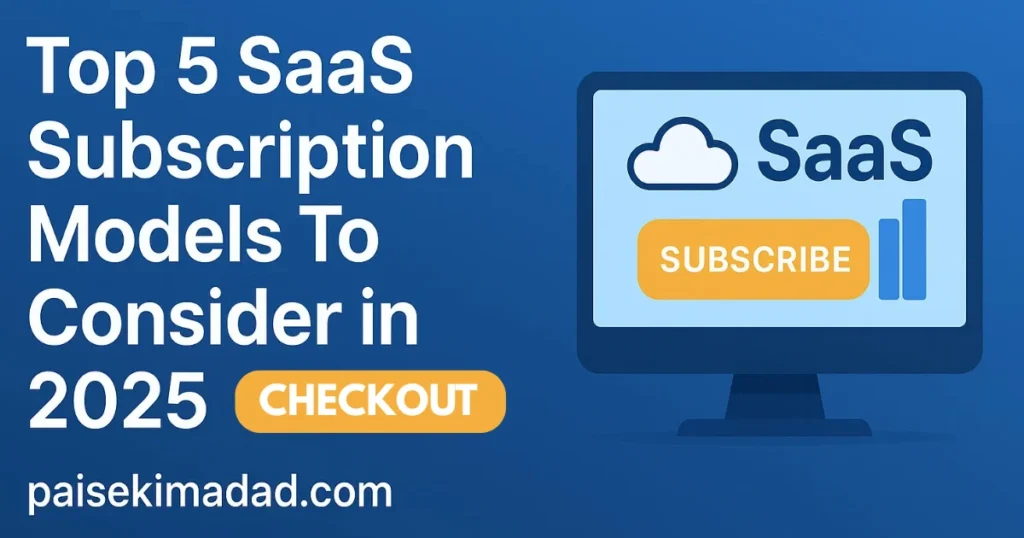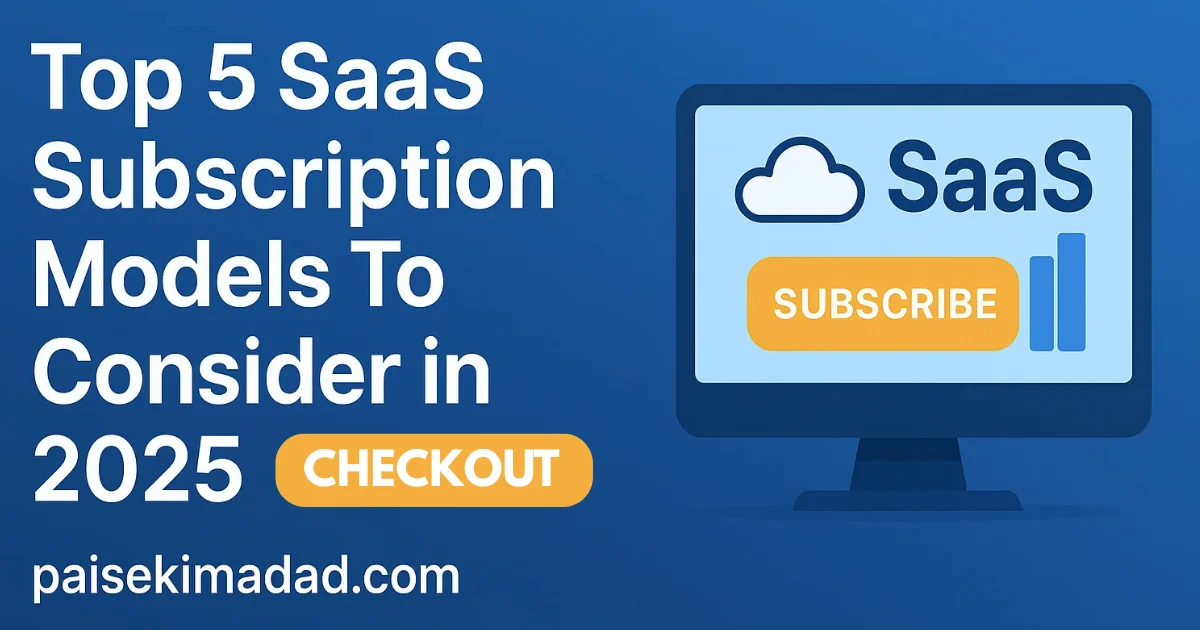Checkout the top 5 SaaS subscription models in 2025, including freemium, flat-rate, tiered, per-user, and usage-based pricing.
The world of software is ever-evolving, and at its heart lies the ubiquitous Software as a Service (SaaS) model. More specifically, the way businesses package and offer their services, often known as SaaS subscription models, has become a critical differentiator in a crowded market.
Understanding these models is not just for software providers; it’s essential for anyone looking to leverage technology effectively. In 2025, the landscape of SaaS subscription models continues to mature, offering diverse options that cater to varying customer needs and business objectives. Let’s delve into the top five models dominating the scene.

What exactly is a SaaS model? Simply put, it’s a software delivery method where software is licensed on a subscription basis and is centrally hosted. Instead of purchasing and installing software, users access it over the internet, typically through a web browser. This fundamental shift has given rise to the sophisticated SaaS subscription models we see today, moving away from one-time purchases to ongoing relationships.
1. The Freemium Model: Luring with Value
The Freemium model remains a powerful entry point for many users into the world of SaaS subscription models. It offers a basic version of a product for free, with limited features or usage, and then entices users to upgrade to a paid premium version for enhanced functionality, increased capacity, or an ad-free experience. Think of popular project management tools or communication platforms that let you start for free but encourage you to subscribe for team features or more storage.
The beauty of this particular SaaS subscription model example lies in its ability to acquire a large user base without significant marketing spend. Users get to experience the product firsthand, building trust and familiarity before committing financially. The key to success with freemium is to offer enough value in the free tier to attract users, but also to create compelling reasons for them to convert to a paid subscription.
2. Flat-Rate Pricing: Simplicity and Predictability
For businesses seeking straightforwardness in their SaaS subscription models, flat-rate pricing offers a clear and predictable solution. With this model, customers pay a single, fixed price to access all features of the software, often for a specific period (e.g., monthly or annually). There are no tiers, no usage-based charges – just one price for everything.
This model is particularly attractive to small businesses or individuals who prefer transparency and don’t want to worry about fluctuating costs. It simplifies the purchasing decision and billing process. However, the challenge for providers using this software as a service subscription model is to find a price point that is appealing to the majority of their target market while also covering their operational costs and generating profit. It might not suit users who only need a subset of features, potentially leading to perceived overpayment.
3. Tiered Pricing: Scaling with Your Needs
Perhaps the most common and versatile of all SaaS subscription models is tiered pricing. This model offers multiple packages or tiers, each with a different set of features, usage limits, or levels of support, and consequently, a different price. As a business grows or its needs evolve, it can easily upgrade to a higher tier that offers more advanced functionalities.
Consider a customer relationship management (CRM) software that offers a “Basic” tier for small teams, a “Professional” tier with advanced analytics and integrations, and an “Enterprise” tier with custom solutions and dedicated support. This SaaS subscription pricing models approach caters to a diverse customer base, allowing users to choose a plan that perfectly aligns with their current requirements and budget. It effectively captures value at different stages of a customer’s journey and is a staple for understanding SaaS subscription meaning in today’s market.
4. Per-User Pricing: Growing with Your Team
Another prevalent SaaS subscription model is per-user pricing, also known as per-seat pricing. As the name suggests, the cost of the software is determined by the number of individual users or “seats” that access it. This is a very common approach for collaboration tools, internal communication platforms, and many business applications where individual access is key.
The primary advantage of this SaaS subscription model example is its simplicity and scalability. As a team grows, the cost increases proportionally, making it easy for businesses to budget and understand their software expenses. It’s also perceived as fair, as customers only pay for the licenses they actively use. However, it can become expensive for large organizations, and some businesses might try to limit user accounts to save costs, which could hinder productivity or collaboration. This directly ties into SaaS subscription-based business models where the value is directly linked to individual access and productivity.
5. Usage-Based Pricing: Paying for What You Consume
Usage-based pricing, sometimes called consumption-based pricing, is gaining significant traction, particularly for services where consumption can vary widely. With this model, customers pay based on how much they actually use a particular feature or resource, such as storage space, API calls, data transfers, or processing power. Cloud computing services are a prime example of this type of SaaS subscription model.
This SaaS subscription data model is highly flexible and can be very cost-effective for users who have fluctuating demands. They only pay for what they consume, eliminating wasted spending on unused features or capacity. For providers, it can align revenue more closely with the value delivered and incentivize efficient resource utilization. The challenge lies in accurately tracking usage and making billing transparent and easy to understand for customers.
The Future of SaaS Subscription Models
As we move further into 2025, the evolution of SaaS subscription models will continue, with hybrid approaches becoming increasingly popular. Many businesses will combine elements of these models to create unique offerings that better fit their specific product and target audience. For instance, a tiered model might incorporate usage-based pricing for certain premium features. The core objective remains the same: to provide value to the customer while ensuring a sustainable and profitable business model for the SaaS provider. The understanding of “What is a SaaS subscription model?” is constantly being refined by these innovative approaches.
FAQs about SaaS Subscription Models
Q1: What is a SaaS subscription model?
A1: A SaaS subscription model is a business strategy where software is delivered over the internet and licensed on a subscription basis, typically involving recurring payments for access to the service rather than a one-time purchase.
Q2: What is the main difference between a SaaS subscription model and traditional software licensing?
A2: The primary difference is that with a SaaS subscription model, you pay to use the software for a specific period (e.g., monthly or annually) and access it online, while traditional licensing involves buying the software once and installing it on your own hardware.
Q3: Can you give a SaaS subscription model example of a freemium offering?
A3: A common example is a project management tool that offers a free plan with limited projects and users, encouraging you to upgrade to a paid plan for unlimited projects, advanced features, and more team members.
Q4: What is SaaS subscription meaning in terms of flexibility for users?
A4: SaaS subscription models generally offer greater flexibility as users can often upgrade or downgrade their plans based on their evolving needs, without the large upfront investment associated with traditional software.
Q5: How do SaaS subscription pricing models benefit businesses?
A5: For businesses, SaaS subscription models provide predictable recurring revenue, foster ongoing customer relationships, and allow for continuous product improvement and updates, leading to higher customer lifetime value.
Disclaimer: This article is for informational purposes only and does not guarantee any earnings or financial results. Readers are advised to do their own research or consult a financial advisor before making any decisions.
